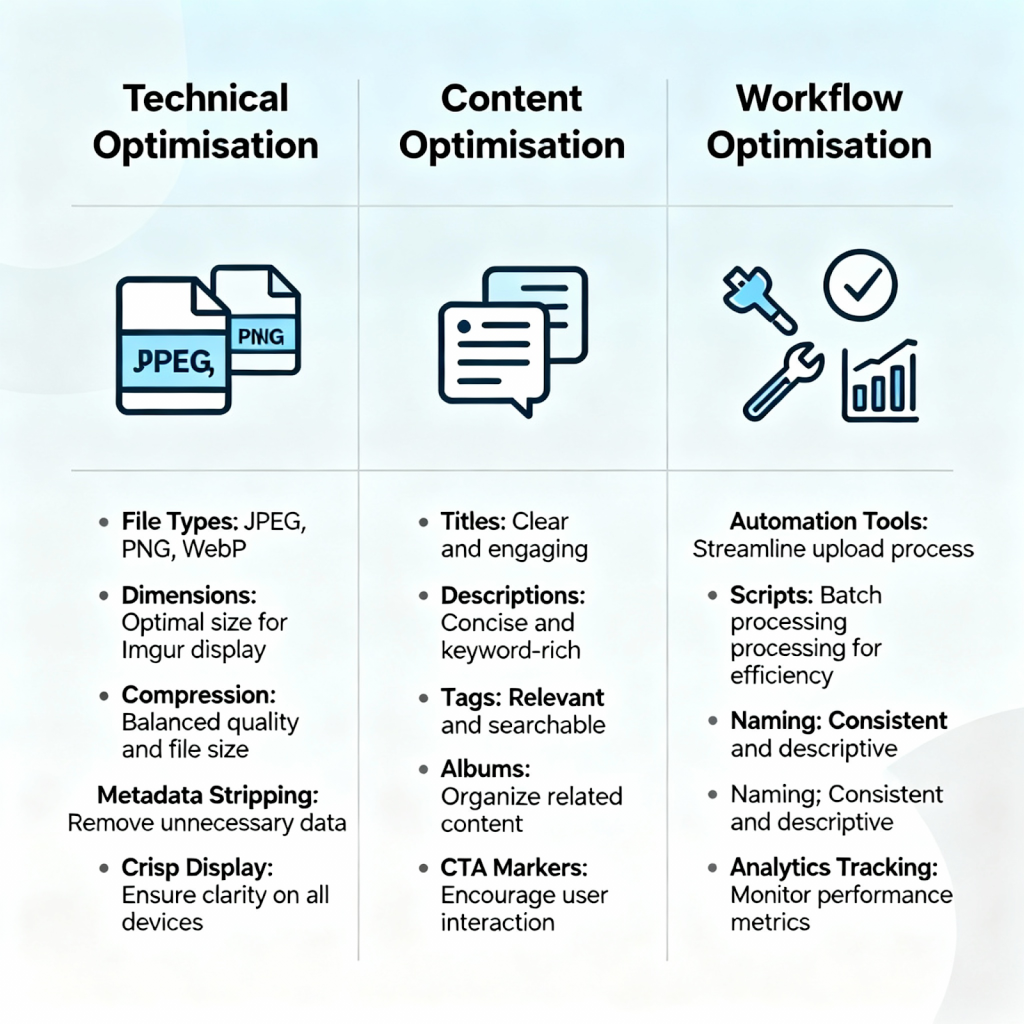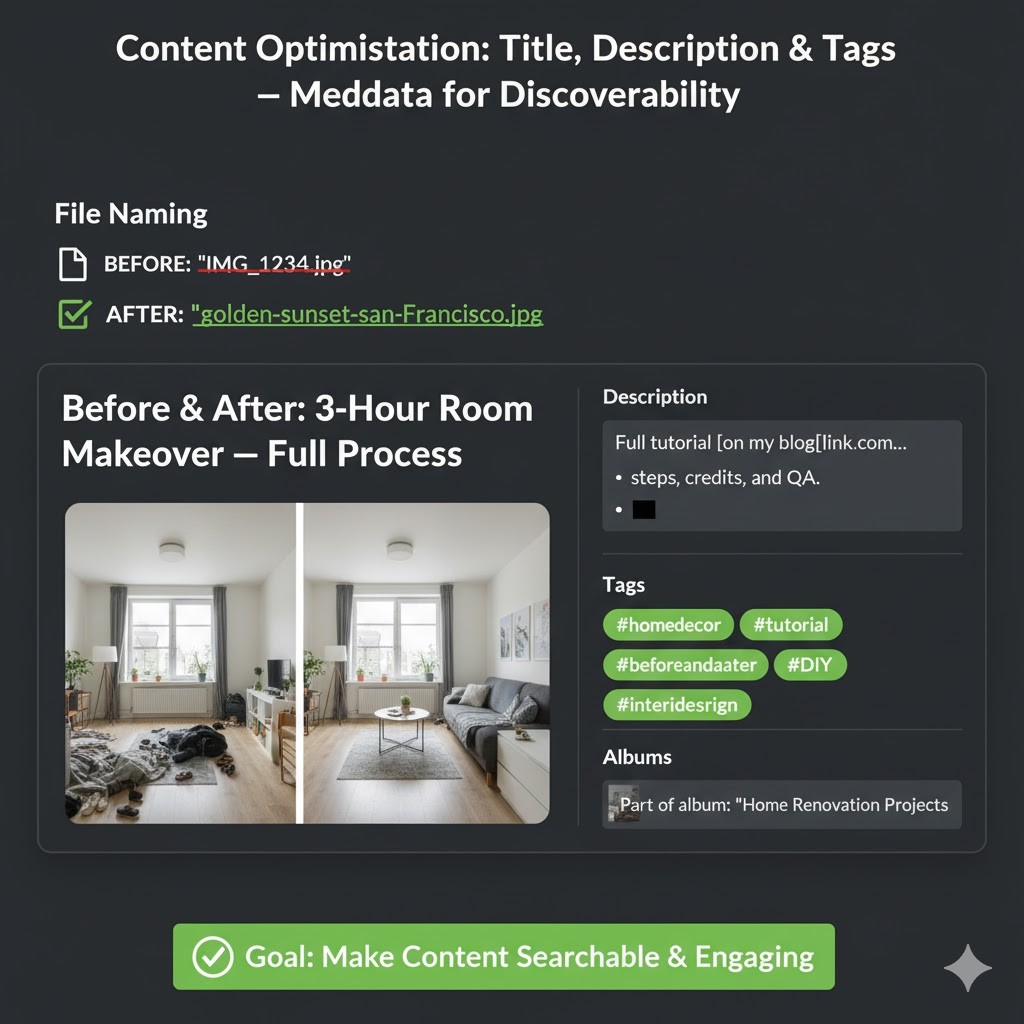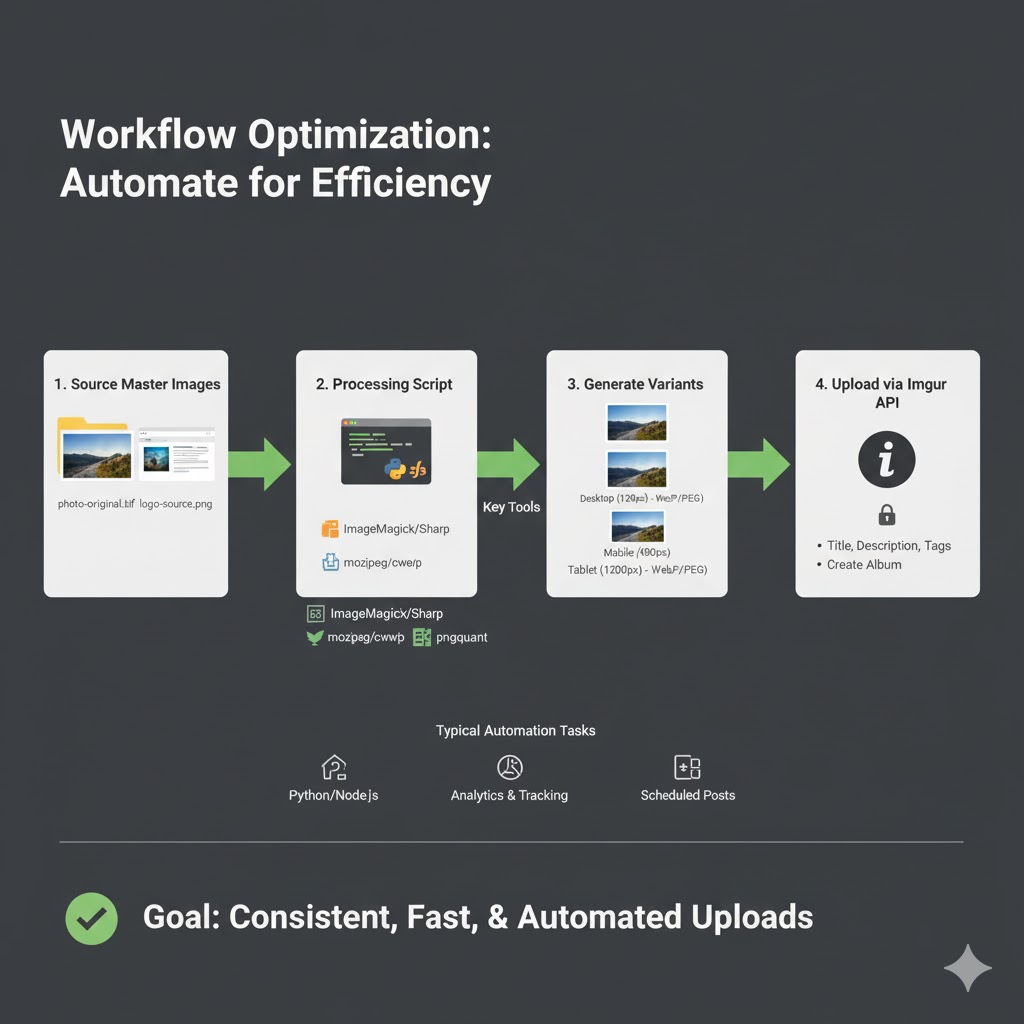SUPERCHARGE YOUR ONLINE VISIBILITY! CONTACT US AND LET’S ACHIEVE EXCELLENCE TOGETHER!
Want your images to load faster, rank better, and drive more clicks and engagement from Imgur and beyond? This step-by-step guide walks you through everything — from file formats and compression to metadata, albums, cross-posting strategies, analytics, automation and troubleshooting. Read it like a practical playbook, with checklists, examples, and real-world tips you can apply immediately.

Imgur began as a fast, simple image sharing site and has grown into an ecosystem used by millions for memes, tutorials, photojournalism, comics, and more. If you rely on Imgur to host or share images — whether for personal projects, social promotion, or embedding images into a website or forum — optimising your images will improve:
- Page load speed (faster images = better UX)
- Engagement (users are more likely to view and upvote crisp, fast-loading content)
- Search visibility — Imgur’s site search and external search engines can surface well-titled/described content
- Bandwidth costs (for you, if you’re hosting externally and serving across networks)
- Accessibility (alt text, good descriptions help visually impaired users and SEO)
- Shareability (images that present well on mobile/social platforms are shared more)
This guide covers practical techniques you can apply today — from the single image to large batch pipelines.
Quick overview: what “optimising for Imgur” means
Optimising for Imgur is a combination of technical precision, creative content design, and efficient workflow management. It’s not just about uploading an image — it’s about making that image load quickly, appear beautifully on all devices, rank well in Imgur’s ecosystem, and attract engagement across multiple platforms.
Technical Optimisation
This focuses on the performance and quality of your images. It includes choosing the correct file type (JPEG, PNG, or WebP) based on the image’s purpose, maintaining the right dimensions for various screens, and applying smart compression to reduce file size without sacrificing clarity. Proper optimisation ensures faster delivery, reduced bandwidth use, and a better user experience. It also involves stripping unnecessary metadata, using progressive JPEGs or WebP for web speed, and verifying that your uploads display crisply on both mobile and desktop.
Content Optimisation
Even the most technically perfect image needs context to perform well. This includes crafting a compelling title, writing a concise yet informative description, adding relevant tags, and organising images within albums for better storytelling. A strong call-to-action (CTA) — such as encouraging shares, comments, or cross-platform engagement — increases visibility and interaction within the Imgur community and beyond.
Workflow Optimisation
For creators and marketers managing multiple images, workflow efficiency is key. Automating repetitive tasks like resizing, compressing, naming, and uploading through scripts or tools saves time and ensures consistency. Maintaining metadata templates, using a structured naming convention, and tracking analytics help refine performance over time. This holistic optimisation approach transforms Imgur from a simple image host into a powerful content distribution and engagement platform.

Choosing the right image format
Selecting the right image format is the foundation of Imgur optimisation. It directly affects your image’s quality, file size, loading speed, and compatibility across different devices and platforms. Each file format has unique strengths and limitations, and understanding when to use each one ensures your uploads perform efficiently while maintaining visual appeal.
JPEG (JPG)
Best for: Photographs, portraits, and images with gradients or complex colour transitions.
JPEG is one of the most widely used formats due to its excellent compression capabilities. It can significantly reduce file size while maintaining acceptable quality, making it ideal for high-resolution photos and large visual collections. Progressive JPEGs — which load in layers of increasing detail — improve perceived loading times, providing a smoother viewing experience on slow connections.
Pros: Great balance between quality and file size; universally supported across all browsers and devices; supports millions of colours.
Cons: JPEG is a lossy format, meaning every time you re-save an image, it loses a bit of detail. It’s also not suitable for text-heavy graphics or images requiring transparency, as these can appear pixelated or blurred.
PNG
Best for: Logos, icons, screenshots, and any image requiring transparency.
PNG offers lossless compression, preserving every detail of the original image. It’s the preferred choice for images containing sharp edges, text, or flat colours, such as infographics or UI elements. PNG also supports transparent backgrounds, which is crucial for overlay designs and web graphics.
Pros: Maintains perfect image fidelity; supports transparency; ideal for text and line art.
Cons: Produces larger file sizes than JPEG for photos; to mitigate this, use PNG-8 instead of PNG-24 whenever possible, as it limits the colour palette while keeping quality high.
WebP
Best for: A modern replacement for JPEG and PNG; suitable for both photos and graphics.
WebP, developed by Google, combines the best of both worlds — superior compression and high visual quality. It can achieve 30–40% smaller file sizes than JPEG or PNG with no visible quality loss. Additionally, WebP supports transparency (like PNG) and animation (like GIF), making it extremely versatile.
Pros: Smaller files, faster loading, supports both lossy and lossless compression.
Cons: Earlier browser support was limited, but now it’s widely compatible. Imgur natively supports WebP uploads and automatically serves them to compatible browsers, ensuring optimal performance.
GIF / APNG / Animated WebP
Best for: Memes, short animations, or reaction loops.
GIFs are universally supported but inefficient. They’re limited to 256 colours and produce large file sizes, especially for longer clips. For better results, use Animated WebP or APNG when supported. These formats provide smoother motion, better colour depth, and drastically reduced file sizes. For longer animations, convert to MP4 video, which offers up to 90% smaller size with similar quality.
HEIC / HEIF
Best for: Mobile photography on Apple devices.
Apple’s HEIC/HEIF formats capture high-quality images at smaller file sizes. However, their limited compatibility across platforms makes them impractical for Imgur. Always convert HEIC to JPEG or WebP before uploading to ensure universal viewing.

Resolution, aspect ratio, and cropping best practices
Imgur displays images responsively across desktop and mobile. Mind the following:
Recommended dimensions
- Maximum dimensions: upload at the size you expect to display. For full-screen desktop viewing, 1920px wide is often enough. For large print or high DPI uses, keep original masters.
- Responsive images: consider uploading versions for 1x and 2x (retina) displays if you control the embedding site.
- Thumbnails: Imgur auto-generates thumbnails but you can influence appearance via crop.
Aspect ratios and composition
- Common ratios: 16:9, 4:3 for landscape; 3:4 for portrait; 1:1 for social feed aesthetics.
- Center of interest: use the rule of thirds when cropping; ensure focal points are not cut by automated thumbnails.
- Vertical images: Imgur and many social platforms favor portrait images for mobile scrolling — but be mindful of file size.
Cropping tips
- Crop out extraneous background to lower file size and increase visual impact.
- For screenshots, crop tightly around content, keeping padding consistent.

Compression: tools and quality tradeoffs
Compression is one of the most critical elements in Imgur optimisation. It determines how fast your images load, how much bandwidth they consume, and ultimately, how smooth your audience’s experience is. The goal is simple — achieve the smallest possible file size without noticeable loss in visual quality. Effective compression helps your Imgur uploads render quickly while maintaining crispness and colour accuracy, especially for users on mobile or slower networks.
Lossy vs. Lossless Compression
There are two main compression types — lossy and lossless — each suited to specific use cases:
- Lossy compression (JPEG, WebP lossy):
Lossy algorithms permanently remove some image data to reduce file size dramatically. This method is perfect for photographs and realistic images where slight reductions in detail aren’t noticeable to the naked eye. For JPEGs, aim for a quality level of 70–85 to strike the best balance between quality and file size. WebP lossy can achieve similar visual results at 60–80 quality, offering even smaller files. - Lossless compression (PNG, WebP lossless):
This method preserves every bit of the original image data, ensuring perfect quality at the cost of larger file sizes. It’s ideal for screenshots, text-heavy images, line art, and graphics with transparency. When clarity and precision are non-negotiable, lossless formats are the best choice.
Recommended Compression Tools (Desktop & Web)
A variety of tools can help you compress efficiently while maintaining visual quality. Below are some of the most effective options used by professionals:
- ImageOptim (Mac): Handles both lossy and lossless compression, automatically stripping unnecessary metadata.
- TinyPNG / TinyJPG: Web-based tools with APIs for developers; excellent results for PNG and JPEG with minimal quality loss.
- Squoosh.app: Open-source browser app by Google that supports multiple formats (JPEG, PNG, WebP, AVIF). It allows side-by-side previews to fine-tune compression settings visually.
- jpegoptim / mozjpeg: Command-line tools ideal for batch-optimising JPEGs with fine control over quality and progressive encoding.
- pngquant: Reduces PNG colour palettes for smaller file sizes with slight, controllable quality tradeoffs.
- cwebp / libwebp: Converts JPEG or PNG files to WebP, offering granular control over compression level and transparency.
These tools balance automation with flexibility, allowing creators to compress manually or integrate optimisation into their workflows.
Compression Settings & Best Practices
- Photographs: Use JPEG (quality 75–85) or WebP (quality 60–80) for sharp yet compact results.
- Screenshots, icons, and graphics: Use PNG-8 with optimised colour palettes, or WebP lossless if transparency is required.
- Animated content: Avoid large GIFs; instead, convert them to MP4 or animated WebP. MP4 offers significant file size savings and better performance across all platforms.
Metadata Stripping
Image files often contain EXIF metadata, such as camera model, GPS coordinates, and shooting parameters. While useful for photographers, this data unnecessarily inflates file sizes and may pose privacy concerns. Most modern compression tools, including ImageOptim, jpegoptim, and TinyPNG, allow automatic metadata removal. Removing it ensures faster uploads, cleaner files, and reduced weight without affecting image quality.
File naming, titles, descriptions, and tags — metadata that helps discoverability
Imgur isn’t just a CDN — it’s a community and a site that can surface content through titles, tags, and descriptions.
File names (before upload)
- Use descriptive, SEO-friendly filenames: golden-gate-sunset-san-francisco.jpg rather than IMG_1234.jpg.
- Keep words separated by hyphens (preferred for SEO).
Titles
- Your Imgur title is the primary discoverability field. Make it:
- Short (under 60 characters) but descriptive.
- Keyword-focused without being spammy.
- Engaging (pose a question, tease value): “Before & After: 3-Hour Room Makeover — Full Process”.
- Short (under 60 characters) but descriptive.
Descriptions
- Use the description to add context, links (Imgur supports links), credits, and an extended caption.
- Include timestamps, camera/settings if relevant, or steps if it’s a tutorial.
- Use markdown for formatting (Imgur supports basic markdown) — add bullet lists, bold, or inline links.
- Caveat: avoid overloading descriptions with promotional links which may trigger moderation or reduce organic engagement.
Tags
- Apply relevant tags — Imgur uses tags for community surfacing. Use tags sparingly and accurately.
- Examples: photography, tutorial, memes, beforeafter, architecture.
- Include niche tags for communities that will be interested.
Albums
- Group related images into albums and give the album a descriptive title and description .

Albums, sequences, and storytelling — structuring content on Imgur
Albums are powerful: they keep content organized, let viewers progress through a narrative, and increase time on page.
When to use albums
- Multi-step tutorials (before/after, steps).
- Photo sets (events, galleries).
- Meme compilations or series.
Best practices for albums
- Order intentionally: first image should be the hook/thumbnail. Imgur uses the first image as album thumbnail.
- Use captions for each image to guide the viewer.
- Keep album sizes reasonable — long albums (50+) can be overwhelming. Consider splitting into volumes.
- Include a table of contents in the album description for long tutorials.
Posting strategy: timing, captions, and call-to-actions (CTAs)
Posting strategy can significantly affect visibility and shares.
Timing
- Post when your target audience is most active. Imgur’s community is global but skews US/Europe — evenings in those timezones can be effective.
- Experiment and use analytics to find peaks.
Captions that convert
- Keep the headline catchy.
- Lead with value: “How I cut my site’s image size by 70% — step-by-step”.
- Add a CTA: “View the source files”, “Ask me anything”, or “Share if you found this useful”.
Engage with comments
- Reply to comments quickly; engagement increases visibility and organic reach.
- Use pinned comments to provide updates, corrections, or links.
Cross-posting & embedding: Reddit, Twitter, blogs, and websites
Imgur historically interplays closely with Reddit and other platforms. Use this to your advantage.
Reddit & communities
- Cross-post with care: match subreddit rules (no self-promotion in certain subreddits).
- Use Imgur links rather than hosting images elsewhere for Reddit posts — Reddit can render Imgur albums inline.
- Tailor title and content to the subreddit’s style.
Twitter/X, Facebook, Instagram
- Some platforms favor native uploads (images uploaded directly to the platform). But linking to Imgur can be useful when you want to direct traffic to an album or include many images.
- For Twitter/X, use short, punchy captions and lead with a striking image.
Embedding in blogs/websites
- Embedding Imgur images is easy (Imgur provides embed code), but hosting on Imgur means you’re dependent on their CDN and policies.
- For performance and control, host critical images on your own CDN and use responsive srcset techniques.
Imgur hosting for websites — pros, cons, and best practices
Many use Imgur as an image host for websites and forums. Consider the tradeoffs.
Pros
- Free hosting and CDN delivery.
- Easy image sharing and embed codes.
- Album functionality and simple UI.
Cons
- No SLA or guaranteed uptime for commercial use.
- Hotlinking policies can change; image deletion or account removal impacts your site.
- Limited control over caching headers and image variants.
Best practices if you choose Imgur as host
- Keep originals in your own backups — don’t rely on Imgur as the only storage.
- Use Imgur for non-critical images (e.g., community uploads, user-submitted content), while hosting core assets on your CDN.
- Monitor bandwidth and load times — leverage srcset and lazy loading for performance.
Accessibility and inclusive optimisation (alt text, descriptions)
Accessible images benefit all users and improve SEO.
Alt text
- Write concise, descriptive alt text for each image.
- Include relevant keywords where natural, but focus on description for screen readers.
- For decorative images, use empty alt (alt=””) so screen readers skip them.
Long descriptions
- For complex images (diagrams, charts), include long descriptions in the image’s description or adjacent text.
- Use step-by-step alt text for process images in tutorials.
Analytics: measuring performance and A/B testing images
To truly optimise your Imgur strategy, you must move beyond uploading and start measuring performance. Analytics give you insight into how your images are performing, which types of content resonate with viewers, and what improvements can boost engagement. Tracking and testing help you make data-driven decisions instead of relying on guesswork.
On-Imgur Metrics
Imgur provides built-in analytics that include view counts, upvotes, comments, and engagement metrics. These numbers reflect how well your content connects with the Imgur community. A high number of views indicates strong reach, while a high ratio of upvotes and comments shows that your audience finds the content interesting or valuable. Analysing these statistics over time helps you identify patterns — such as which formats, captions, or posting times drive the best results. Use this data to refine future uploads and replicate your most successful strategies.
A/B Testing Images
A/B testing is a powerful method to determine what works best. Create two versions of the same image post (A and B) with only one variable changed — for example, the crop, title, call-to-action (CTA), or description. Upload both versions at similar times and to the same type of community to keep the conditions fair. Then compare views, upvotes, comments, and click-through rates (CTR). Even small adjustments can yield noticeable improvements in engagement and visibility.
Off-Site Analytics
If your Imgur images are embedded on your website or shared through other platforms, integrate Google Analytics or similar tools to track performance. Use UTM parameters in the image description links to monitor referral traffic from Imgur. This helps you understand how Imgur contributes to your broader digital ecosystem, allowing you to refine both your content strategy and your audience targeting effectively.
Automation: scripts, image pipelines, and CMS integration
For regular uploads, automation saves time and ensures consistency.
Basic pipeline
- Source master images in a folder with standardized filenames.
- Use a processing script (ImageMagick, Pillow, or libvips) to generate variants:
- image-1200.jpg (desktop)
- image-800.jpg (tablet)
- image-400.jpg (mobile)
- image-1200.jpg (desktop)
- Run compression tools (mozjpeg, cwebp) automatically.
- Upload via Imgur API with metadata (title, description, tags).
Imgur API
- Use the Imgur API (requires client ID/secret and tokens) to upload images, create albums, and add descriptions programmatically.
- Respect rate limits and content policies.
- Typical automation tasks:
- Bulk upload and album creation
- Scheduled posts
- Fetching analytics and comments for a dashboard
- Bulk upload and album creation
Example script choices
- Python: requests + imgurpython libraries; integrate with Pillow for image manipulation.
- Node.js: imgur package for upload workflows; use sharp for fast image processing.
- Bash: curl with imagemagick, jpegoptim, and cwebp for simple CLI pipelines.

Monetisation & community growth strategies on Imgur
If you want to grow a presence or monetise content, follow these guidelines:
Organic growth
- Post consistently and engage daily.
- Participate in niche communities; share value rather than self-promotion.
- Series content (weekly tutorials or photo sets) keeps users returning.
Monetisation
- Link to Patreon, Ko-fi, or a shop in descriptions (observe Imgur rules on sponsorship).
- Use CTAs to drive traffic to conversion pages (email signup, product pages).
- Offer downloadable assets (presets, templates) via links in descriptions.
Sponsorship & partnerships
- Partner with complementary creators for cross-promoted albums.
- Offer exclusive behind-the-scenes images for paid subscribers (off-Imgur).
Troubleshooting: common problems and fixes
Image looks blurry after upload
- Ensure you uploaded a high enough resolution and used appropriate compression settings.
- Avoid upscaling small images; start with a properly sized master.
Large file sizes after compression
- Check for unnecessary metadata (strip EXIF).
- Use more aggressive lossy settings or convert to WebP.
Imgur rejects/flags uploads
- Review Imgur’s community guidelines; copyrighted material, NSFW content, or policy violations can result in removal.
- Ensure you have rights to the images you upload.
Slow delivery
- Confirm Imgur’s CDN is not blocked in your target region.
- For mission-critical assets, use a dedicated CDN.
Advanced topics
Once you’ve mastered the basics of image formatting, compression, and metadata, it’s worth exploring advanced optimisation techniques that can make your uploads even more efficient and professional. These approaches focus on enhancing loading speed, improving user experience, and adopting next-generation image standards that deliver superior results with smaller file sizes.
Progressive JPEGs
A Progressive JPEG is a special variant of the traditional JPEG format designed to improve perceived loading speed. Instead of loading line by line from top to bottom, a progressive JPEG first displays a low-quality preview and then gradually sharpens as more data loads. This technique gives users the impression that images are loading faster — a major advantage on slower connections or mobile networks. You can create progressive JPEGs using tools such as jpegoptim, mozjpeg, or ImageMagick. For photography-heavy Imgur uploads or blogs embedding Imgur images, progressive JPEGs significantly enhance the browsing experience.
Image Sprites and CSS
For websites and user interfaces that require multiple small icons or UI elements, using CSS image sprites is a classic optimisation technique. By combining multiple icons into a single image file and displaying specific portions with CSS, you reduce the number of HTTP requests, which speeds up page loading. However, this approach is less relevant for Imgur hosting, since Imgur already uses a content delivery network (CDN) that optimises image delivery. Sprites are best applied when you manage your own hosting or serve custom UI assets.
AVIF and Next-Generation Formats
The AVIF format is emerging as a successor to WebP, offering even smaller file sizes and superior quality at the same compression levels. AVIF supports HDR, transparency, and a wide colour gamut — ideal for professional-grade imagery. However, browser support is still evolving. For now, consider using AVIF where supported, with fallbacks to WebP or JPEG to ensure universal compatibility. Tools like Squoosh, libavif, and Sharp can generate AVIF files effectively.
Video Over GIF
Animated GIFs, while popular, are inefficient and bulky. They often consume large amounts of bandwidth for relatively short clips. A more advanced strategy is to convert GIFs into MP4 or WebM videos. These video formats provide drastically smaller file sizes, smoother playback, and better colour representation. Imgur automatically converts long or complex GIFs into MP4 for streaming, making this process seamless for users. By prioritising video formats over GIFs, you save storage space, reduce loading time, and enhance playback performance — especially important for memes, tutorials, or animation sequences.
Privacy, copyright, and legal considerations
- Ownership: only upload images you own or have rights to. Uploading copyrighted images without permission can result in takedowns.
- Model releases: for commercial use of images containing people, secure releases.
- Privacy: avoid publishing private personal info — faces, license plates, addresses — without consent.
SEO Optimisation for Imgur and External Search Engines
Imgur is more than a hosting service — it’s a search-indexed content platform. Optimising your images for SEO (Search Engine Optimisation) helps them surface not only inside Imgur’s own search and tag systems but also in Google Images, Bing Visual Search, Reddit embeds, and external blogs. Smart SEO ensures your uploads continue driving organic traffic long after you post them.
Understand How Search Works on Imgur
Imgur’s search ranking depends on multiple factors:
- Title relevance: The title must directly describe the image’s content or story.
- Tags: Imgur relies heavily on tags to classify content for users browsing specific topics.
- Engagement metrics: High upvotes, comments, and shares signal that content is worth promoting.
- Recency: Fresh posts tend to perform better in feeds and tag searches.
To maximise discoverability:
- Use 3–5 highly relevant tags, mixing broad and niche ones. For instance, “photography,” “streetphoto,” and “urbanexploration.”
- Avoid keyword stuffing — natural phrasing works best.
- Keep titles short (under 60 characters) but descriptive, like “Golden Hour Over Tokyo — Unedited Shot from Skytree.”
External Search Engine Optimisation (Google, Bing, etc.)
Because Imgur images are public, they can appear in Google Images and web search results. You can boost visibility through these methods:
A. Use Descriptive File Names Before Uploading
Google uses file names to interpret image content. Rename “IMG_2031.JPG” to “northern-lights-iceland-landscape.jpg” before uploading.
B. Optimise Descriptions for Keywords
Your Imgur description is crawlable. Add natural phrases users might search for:
“Captured during the 2025 Icelandic Aurora season, this shot shows the Northern Lights above Kirkjufell Mountain.”
C. Include Contextual Links
If you embed images in a blog or portfolio, link back to the original Imgur post using consistent anchor text. This builds authority for both your site and your Imgur profile.
D. Use Alt Text Strategically
When embedding Imgur content, provide detailed alt attributes that summarise the image’s subject, mood, and location. Example:
<img src=”…” alt=”Panoramic view of Paris skyline at dusk from Montmartre”>
Rich Metadata and Schema Markup
If you maintain your own website that embeds Imgur-hosted images, add structured data (Schema.org) to describe the image’s author, license, and caption. This improves how Google displays your content in search results — often turning basic thumbnails into rich image snippets.
Engagement as an SEO Multiplier
Search algorithms on both Imgur and Google reward engagement. Encourage interaction by:
- Asking questions in descriptions (“What city would you love to capture next?”).
- Adding community tags for visibility.
- Sharing your Imgur post link across Reddit, X (Twitter), and Threads to increase early traffic.
Avoid SEO Pitfalls
- Don’t keyword-stuff tags or titles — it looks spammy.
- Avoid duplicating identical images across multiple Imgur posts.
- Refrain from overusing promotional links; Imgur’s algorithm may demote such content.
When done right, Imgur SEO turns each upload into an evergreen content asset, discoverable both in the Imgur feed and across major search engines, multiplying the reach of your visual content for years.
Performance Maintenance, Archiving, and Long-Term Image Management
Optimisation isn’t a one-time task — it’s a continuous process. As your image library grows, maintaining performance, managing archives, and monitoring link health become crucial to sustaining quality and reliability. This section focuses on long-term optimisation and maintenance strategies for creators, marketers, and brands using Imgur extensively.
Periodic Performance Reviews
Every three to six months, conduct an optimisation audit:
- Check loading speed: Use tools like PageSpeed Insights or GTmetrix on pages embedding Imgur images.
- Inspect image dimensions: Ensure no oversized images are being scaled down unnecessarily.
- Review compression levels: Recompress older uploads with new formats (e.g., convert PNG to WebP).
Establish benchmarks for key metrics:
- Average image file size (aim for under 500 KB for photos, under 100 KB for icons).
- Average engagement per post (views, upvotes, shares).
- Traffic referral percentage from Imgur to your site.
Version Control and Backups
Even though Imgur stores your images, never rely solely on it as your permanent archive. Keep original master files on a local drive or cloud storage like Google Drive, Dropbox, or Amazon S3. Implement simple versioning:
- filename_v1.jpg → filename_v2.webp → filename_v3.avif.
This allows you to track quality changes across compression updates.
For large-scale workflows, automate backups using Imgur’s API to periodically download all uploaded files to your storage.
Link and Embed Health Monitoring
If you use Imgur-hosted images in articles, documentation, or eCommerce listings, check quarterly for broken or removed links. Imgur may delete files violating their policy, or URLs might change. Use a link monitoring tool like Ahrefs, Dead Link Checker, or Screaming Frog to detect 404s early.
Maintain a spreadsheet of critical Imgur URLs alongside your own file storage links. This helps you restore lost embeds quickly if a post disappears.
Re-Optimising Old Content
Formats evolve. An image uploaded in 2018 as a JPEG might now perform better as a WebP or AVIF. Revisit old high-performing Imgur posts:
- Recompress using modern formats.
- Update descriptions, titles, and tags for current trends.
- Cross-promote again on social platforms — many users haven’t seen your older content.
This keeps your portfolio evergreen and boosts visibility with minimal effort.
Licensing, Attribution, and Content Security
For creators, protecting intellectual property is vital. Always watermark or add subtle identifiers to original artwork or photography. You can also embed copyright information into EXIF metadata before stripping unnecessary data (some tools allow selective retention).
Use Imgur’s privacy settings wisely:
- Public: Indexed by Imgur and search engines.
- Hidden: Viewable via link, not searchable.
- Private: Visible only to you.
For portfolios or client projects, “Hidden” strikes a good balance between accessibility and control.
Migrating or Scaling Beyond Imgur
If you outgrow Imgur — for instance, you run a large photography site or commercial project — you can use your Imgur assets as part of a hybrid hosting setup:
- Keep Imgur for community engagement and quick sharing.
- Use a personal CDN (Cloudflare, Bunny.net) for mission-critical assets.
- Sync metadata and analytics via API to centralise insights.
Maintaining Accessibility and Compliance
Ensure all new and legacy images meet accessibility standards:
- Add or update alt text for embedded Imgur content.
- Check colour contrast and legibility in your visuals.
- Comply with WCAG 2.1 guidelines for any website using your Imgur-hosted media.
Performance Automation
You can automate ongoing performance checks using simple scripts. For example:
- A Python script using the Imgur API + Lighthouse CI to analyse image delivery speed.
- Automated reports via Google Data Studio that track image engagement metrics monthly.
These help you sustain peak performance without manual effort.
When to Rebuild Your Image Library
If analytics show a sharp performance drop, your compression or format strategy may be outdated. Consider a library rebuild:
- Export all Imgur-hosted images.
- Recompress with WebP/AVIF.
- Re-upload with updated metadata and CTAs.
- Redirect traffic to new posts via social shares or blog updates.
This ensures your image ecosystem remains technically modern and audience-friendly.
Wrapping Up
Optimising images for Imgur is both an art and a science, combining technical precision, content strategy, and workflow efficiency to achieve maximum performance, engagement, and discoverability. From choosing the right file format — whether JPEG, PNG, WebP, or MP4 for animations — to applying effective compression, stripping unnecessary metadata, and maintaining responsive dimensions, every decision directly impacts load times, user experience, and bandwidth efficiency. Equally important is content optimisation: compelling titles, informative descriptions, relevant tags, structured albums, and clear calls-to-action all enhance visibility within Imgur’s ecosystem and on external search engines. For creators managing multiple images, automation through scripts, APIs, and batch processing ensures consistency, saves time, and allows analytics tracking to drive data-informed decisions.
Advanced techniques such as progressive JPEGs, next-gen formats like AVIF, and converting GIFs to MP4 elevate performance further. Long-term management, including regular audits, backups, accessibility compliance, and SEO updates, ensures that images remain evergreen, discoverable, and reliable across platforms. By combining these technical, creative, and strategic practices, users can transform Imgur from a simple image host into a robust platform for engagement, growth, and professional content presentation, creating images that are fast, visually appealing, widely shareable, and primed for lasting impact.

